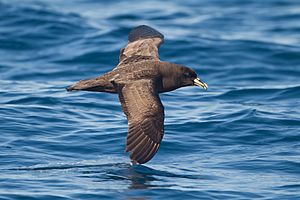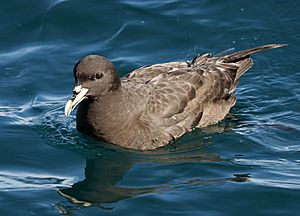White-chinned petrel facts for kids
Quick facts for kids White-chinned petrel |
|
|---|---|
 |
|
| Conservation status | |
| Scientific classification | |
| Genus: |
Procellaria
|
| Species: |
aequinoctialis
|
The white-chinned petrel (Procellaria aequinoctialis), also called the Cape hen, is a large seabird. It belongs to the shearwater group in the Procellariidae family. These birds live all around the Southern Ocean. You can find them as far north as southern Australia, Peru, and Namibia. They build their nests in large groups on different islands.
Contents
About the White-Chinned Petrel
The white-chinned petrel is part of the Procellaria group, which is in the Procellariidae family. This family is part of a larger group of birds called Procellariiformes. These birds have some special features.
First, they have unique nostrils called naricorns. These are special tubes on their upper beak. Even though the petrel's nostrils are on top of its beak, they are still part of this system. Their beaks are also special, made of seven to nine hard plates.
Second, these birds can make a special oily liquid in their stomach. This oil is stored in a part of their stomach called the proventriculus. They can spray this oil out of their mouths to protect themselves from animals that might try to eat them. This oil is also a rich food source for their chicks and for the adult birds when they fly long distances.
Third, they have a salt gland above their nose. This gland helps them remove extra salt from their bodies. They drink a lot of ocean water, so this gland is very important. It lets out a salty liquid from their nose.
What's in a Name?
The name Procellaria comes from two Latin words. Procella means "storm," and arius means "pertaining to." This name refers to how these birds are often seen during stormy weather.
The word petrel comes from the story of Saint Peter walking on water. This is because petrels look like they are running on the water's surface when they are about to fly.
How to Spot a White-Chinned Petrel
The white-chinned petrel is a big bird. It is about 51 to 58 centimeters (20 to 23 inches) long. It weighs between 0.97 and 1.89 kilograms (2.1 to 4.2 pounds). Its wings can spread out to 134 to 147 centimeters (53 to 58 inches). It is the largest petrel in its group, even bigger than most other birds in its family, except for the giant petrels.
This large petrel is mostly a sooty-black color. It has some white on its throat and chin. The white parts are usually more noticeable on birds from the Indian Ocean than those from the Atlantic. The feathers on its wings can look shiny and silver underneath.
Its beak can be horn-colored or yellow with a black tip. It also has a black area between its nostrils. Its feet are black. When it flies, it mixes slow wing beats with long glides. Usually, these birds are quiet. But when they are at their nesting places, they might make rattling or groaning sounds.
White-Chinned Petrel Behavior
Feeding Habits
White-chinned petrels mostly eat krill, which are tiny shrimp-like creatures. They also eat fish. These birds catch their food by grabbing it from the surface of the water or by diving a little bit underwater. They often follow ships to eat the leftover fish that fishermen throw away. This makes them easy targets for longline fishing, which is a type of fishing that uses very long lines with many hooks.
Reproduction and Life Cycle
Both male and female white-chinned petrels work together to build their nest. They also take turns sitting on the egg to keep it warm until it hatches. Once the chick is born, both parents help feed and protect their young one.
Where They Live
White-chinned petrels use many different islands for breeding. About 2 million pairs nest on South Georgia. Between 175,000 and 226,000 pairs live on the Kerguelen Islands. Another 100,000 pairs are found on Disappointment Island. Some also breed on the Crozet Islands, Prince Edward Islands, Campbell Islands, Auckland Islands, Antipodes Islands, and the Falkland Islands.
When it's not breeding season, these petrels fly from the Antarctic ice to warmer, subtropical waters.
Protecting White-Chinned Petrels
In 2004, experts estimated that there were about 7 million adult white-chinned petrels. They live across a very large area, about 44.8 million square kilometers (17.3 million square miles). However, many adult birds and chicks die because of longline fishing. Because of this, the IUCN has listed them as a vulnerable species. This means they are at risk of becoming endangered.
Their population is decreasing. For example, at Bird Island, the number of nests has dropped by 28%. At Prydz Bay, the population has gone down by 86%. On Marion Island, there has been a 14.5% decrease, and on the Crozet Islands, a 37% decrease.
Being accidentally caught by longline fishing is a big reason for their population decline. For instance, almost all the birds caught by mistake (called bycatch) during hake fishing in Namibia are white-chinned petrels. In South Africa, they make up 10% of the bycatch from fishing near the surface (pelagic) and 55% of the bycatch from fishing near the bottom (demersal).
White-chinned petrels have also been harmed by animals that are not native to their islands, like the brown rat and the black rat. These rats can eat their eggs and chicks.
Many of the islands where they breed are protected areas. Scientists are studying and keeping track of their populations on South Georgia, the Prince Edward Islands, Kerguelen Islands, and Crozet Islands. Also, these birds are part of international agreements like ACAP Annex I and CMS Appendix II, which aim to protect them.
To help their numbers grow again, people are suggesting to continue and expand studies. They also want to get rid of most of the invasive animals on the islands. Another important step is to encourage all fishing boats in the petrels' range to use safer fishing methods. This effort is supported by groups like ACAP, FAO, and CCAMLR.
See also
 In Spanish: Pardela gorgiblanca para niños
In Spanish: Pardela gorgiblanca para niños



